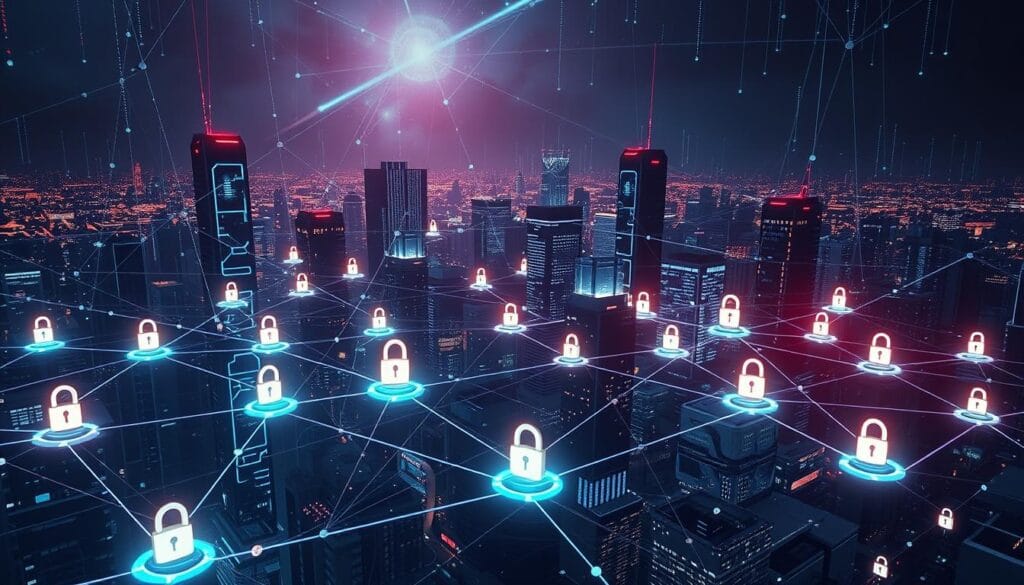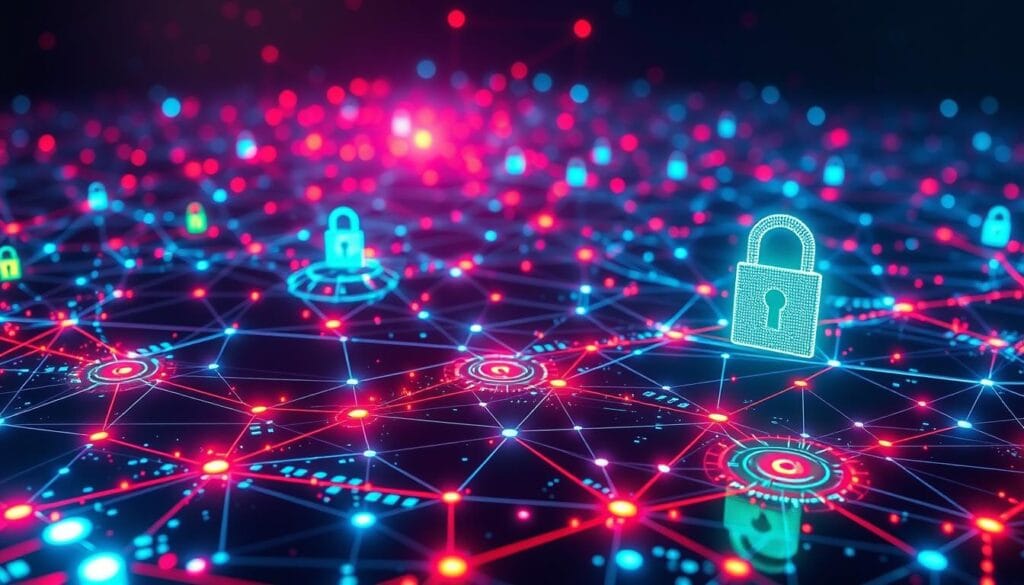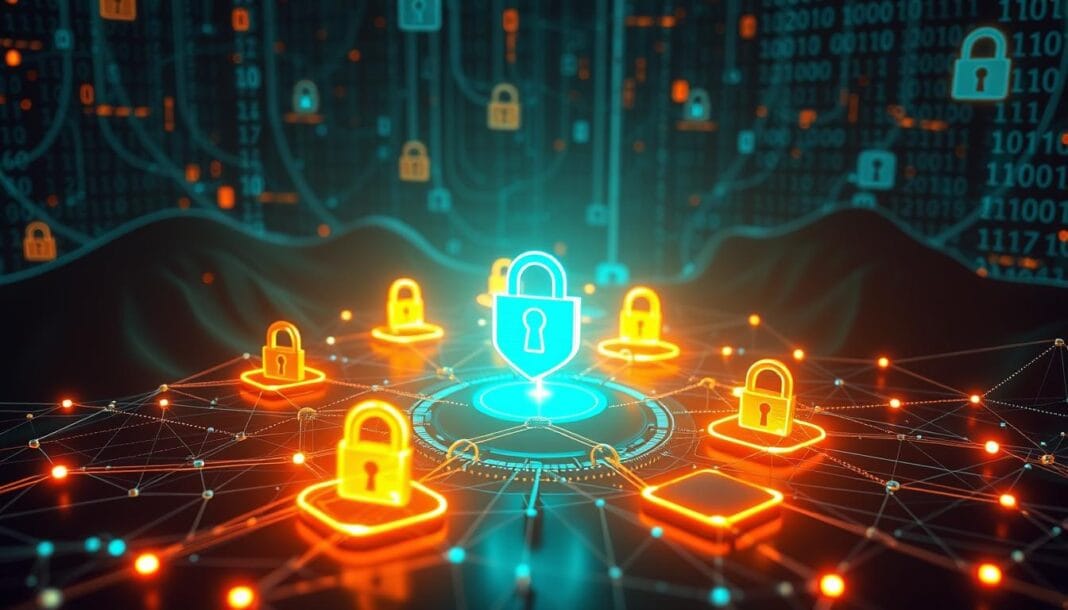Blockchain in Cybersecurity:
In today’s digital era, with our lives becoming more intertwined with technology, ensuring strong cybersecurity measures is more vital than ever. As our reliance on online platforms, cloud storage, and interconnected devices grows, so too does the risk of malicious cyber threats. Imagine a solution that could completely transform how we handle data security and protect our digital assets. Enter blockchain technology, a game-changer in the world of cybersecurity solutions.
Blockchain, initially conceived as the foundation for cryptocurrencies, has evolved into a powerful tool for enhancing digital protection and strengthening data security. Its decentralized nature, cryptographic algorithms, and immutable record-keeping make it a formidable ally in the fight against ever-evolving cyber threats. This article will explore how blockchain is transforming the cybersecurity field, looking at its possible uses, practical examples, and the obstacles it faces.
Blockchain Technology Introduction
Blockchain technology is revolutionizing the digital world by providing a secure and transparent method for storing and transmitting data. At its core, Blockchain, fundamentally, functions as a distributed ledger system facilitating secure and decentralized transaction recording across an interconnected computer network known as nodes. This innovative approach to data management has the potential to revolutionize various industries, from finance to supply chain management.
What is Blockchain?
Blockchain, a distributed ledger decentralized system, logs transactions across multiple computers in a network.
Each public digital ledger transaction undergoes verification, timestamping, and attachment to a cryptographic hash of the previous block, creating a series of blocks known as “blockchain”. The decentralized network guarantees the high security and tamper resistance of blockchain-stored data, making it nearly impossible to modify a single block without impacting the entire chain.
Blockchain’s essential features
- Decentralization: Blockchain functions as a decentralized network, not controlled by a singular entity, but rather by a distributed group of participants called nodes.
- Immutability: Once a transaction is recorded on the blockchain, it becomes highly immutable, as any attempts to alter the data would require consensus from the majority of the network.
- Cryptographic Security: Blockchain uses cutting-edge cryptographic methods, like hash functions, to safeguard the data stored on the network with utmost integrity and security.
- Transparency: The distributed nature of blockchain creates a highly transparent system, as all participants can view and verify the transactions recorded on the public ledger.
Advantages Over Traditional Systems
Compared to traditional centralized systems, blockchain offers several key advantages, including enhanced security, improved transparency, and greater efficiency. The decentralized design of blockchain enhances its resilience against cyberattacks and data breaches by eliminating a central vulnerability. Additionally, the immutable and transparent nature of the blockchain enhances data integrity and enables trusted transactions without the need for a central authority.
Understanding Cybersecurity Threats
Organizations today face a myriad of cybersecurity threats that can have devastating consequences. From data breaches and DDoS attacks to malware and phishing scams, the landscape of cybercrime continues to evolve, posing significant challenges for businesses of all sizes.
Cyber threats frequently encountered by organizations
- Data breaches can result in financial losses and reputational harm due to unauthorized entry into sensitive information like customer data, financial records9, or intellectual property.
- DDoS attacks flood systems with traffic, making them inaccessible to legitimate users and disrupting business operations.
- Malware, comprising viruses, worms, and ransomware, has the ability to penetrate systems, pilfer data, or demand ransom payments, resulting in considerable financial and operational impacts.
- Phishing involves deceptive emails or websites with the aim of fraudulently acquiring sensitive information like login credentials or financial details, potentially leading to data theft and financial harm.
- Ransomware is a type of malware that locks a victim’s files and demands payment in return for the decryption key, leading to disruptions and financial harm.
Cyber Attacks’ Influence
The impact of cyberattacks can be far-reaching, affecting organizations both financially and reputationally. According to a recent study, the average cost of a data breach in the United States is $4.35 million, highlighting the significant financial burden that organizations face. Additionally, the reputational damage caused by high-profile security incidents can erode customer trust and hinder an organization’s ability to operate effectively.
Security Breaches Case Studies
Numerous high-profile security breaches in recent years have demonstrated the vulnerabilities inherent in traditional centralized systems. For example, The Equifax data breach back in 2017 resulted in the exposure of personal data from more than 147 million people. This incident caused major financial and reputation-related repercussions for the credit reporting firm. Similarly, the WannaCry ransomware attack in 2017 affected thousands of organizations worldwide, highlighting the need for more robust cybersecurity measures.
| Cyber Threat | Impact | Case Study |
|---|---|---|
| Data Breach | $4.35 million average cost | Equifax (2017) |
| Ransomware | Widespread disruption | WannaCry (2017) |
“Cybersecurity threats are constantly evolving, and organizations must remain vigilant to protect their assets and reputation.”
Blockchain’s Influence on Boosting Cybersecurity
Blockchain technology is a potent resource within the cybersecurity domain, providing a distinct method to protect data and transactions. Its decentralized architecture, tamper-proof records, and robust consensus mechanisms provide a formidable defense against cyber threats.
Decentralization and Its Benefits
The decentralized feature of Blockchain provides a significant benefit. Blockchain networks, unlike conventional centralized systems, are dispersed among numerous nodes, eradicating any single point of failure. This distributed network structure makes it incredibly challenging for hackers to gain control over the entire system, as they would need to compromise a significant portion of the network to disrupt its operations.
Data Integrity and Immutability
Blockchain technology is renowned for its ability to maintain the integrity of data. Each transaction or record added to the blockchain is cryptographically linked to its predecessor, creating a tamper-proof chain of information. This unchangeability guarantees that once information is documented, it cannot be modified or removed without the agreement of the network, offering a strong level of data security and traceability.
Enhanced Transparency and Auditability
The transparent and auditable nature of blockchain further strengthens its cybersecurity capabilities. All transactions on the blockchain network are publicly visible and can be verified by network participants, fostering trust and accountability. This enhanced transparency makes it easier to detect and prevent fraudulent activities, as any unauthorized modifications would be immediately evident to the network.
| Blockchain Cybersecurity Feature | Benefit |
|---|---|
| Decentralized Architecture | Eliminates single points of failure, making it difficult for hackers to compromise the entire system |
| Tamper-Proof Records | Cryptographic linking of data blocks ensures data integrity and traceability |
| Consensus Mechanisms | Validation and verification of transactions by multiple parties enhances data authentication |
| Transparency and Auditability | Publicly visible transactions and the ability to audit the network increase trust and accountability |
Using blockchain’s distinctive characteristics, companies can greatly improve their cybersecurity stance, reducing the chances of data breaches, unauthorized entry, and other online dangers. As the adoption of blockchain technology continues to grow, its role in shaping the future of cybersecurity will become even more prominent.
Smart Contracts and Cybersecurity
In the realm of cybersecurity, smart contracts have emerged as a game-changing technology. Are self-executing programs that enforce pre-set rules and conditions autonomously. They remove the necessity for intermediaries and decrease the chances of human error or malicious intervention.
Definition of Smart Contracts
Smart contracts are digital agreements that are coded to self-execute when specific conditions are met. These automated contracts leverage the decentralized and immutable nature of blockchain technology to ensure secure transactions and enforce access controls.
Ensuring Transactions through Smart Contracts
By automating security protocols, smart contracts can enhance the security of transactions. They can verify the identity of parties involved, enforce access controls, and ensure the integrity of data throughout the transaction process. This eliminates the need for manual verification, reducing the risk of human error and malicious interference.
Real-world Applications in Cybersecurity
- Secure software updates: Smart contracts can automate the process of verifying and deploying software updates, ensuring the integrity and authenticity of the updates.
- Automated threat detection: Smart contracts can monitor network activity and trigger automated responses to detect and mitigate potential security threats in real time.
- Digital identity management: Smart contracts can be used to manage and verify digital identities, reducing the risk of identity theft and unauthorized access.
As businesses like Microsoft, JPMorgan Chase, Walmart, IBM, and Amazon are already using blockchain and smart contracts to secure payments and transactions, the potential for smart contracts to enhance cybersecurity is becoming increasingly evident.
“Smart contracts automate processes and reduce costs associated with manual verification and third-party oversight in industries where trust and speed are crucial, like supply chain management and real estate.”
With the ability to self-execute, smart contracts can streamline security protocols, ensure secure transactions, and enforce automated security protocols, making them a powerful tool in the fight against self-executing contracts.
Identity Management through Blockchain
In the digital age, safeguarding personal identities has become increasingly crucial. Blockchain technology offers a robust solution for identity management, empowering users to take control of their personal information and mitigate the risks of identity theft. By leveraging the decentralized nature of blockchain, individuals can create self-sovereign identities, ensuring their data is secure, private, and easily verifiable.
Blockchain for Digital Identity
Blockchain’s core principles of decentralization, transparency, and immutability make it an ideal platform for digital identity management. Unlike traditional centralized systems, blockchain-based identity solutions eliminate the need for a single point of failure, where data breaches can compromise sensitive personal information. Instead, identity data is distributed across multiple nodes, enhancing security and reducing the risk of unauthorized access.
Self-Sovereign Identity
The concept of self-sovereign identity empowers users to control their own personal information. With blockchain, individuals can create and manage their digital identities without relying on third-party intermediaries. This approach ensures that users have the ultimate authority over their data, deciding what information to share and with whom. By giving users this control, blockchain-based identity systems enhance privacy protection and enable more secure user authentication across various platforms and services.
Reducing Identity Theft Risks
Identity theft remains a significant threat, resulting in billions of dollars in financial losses annually. Blockchain technology has the potential to greatly reduce these risks. Blockchain’s decentralized and immutable design creates significant challenges for malicious individuals attempting to manipulate or steal personal identity information. Additionally, the use of advanced cryptographic techniques, such as public-key cryptography, strengthens the security of transactions and identity verification processes, reducing the likelihood of successful identity theft attempts.
As the digital landscape continues to evolve, the importance of secure and user-centric identity management cannot be overstated. Blockchain in this field provides a promising solution, enabling individuals to manage their personal information, improve privacy protection, and reduce identity theft risks significantly.
Secure Data Sharing with Blockchain
In today’s data-driven landscape, the need for secure and transparent data sharing has never been more critical. Blockchain technology provides a hopeful answer to this challenge. By providing a decentralized and encrypted platform for information exchange, blockchain facilitates secure data sharing that enhances data privacy, enables permissioned access, and improves interoperability between different systems.
Benefits of Data Sharing
Data sharing offers numerous advantages, including:
- Improved collaboration and knowledge exchange
- Enhanced transparency and accountability
- Making well-informed decisions using thorough data
- Accelerated innovation through data-driven insights
How Blockchain Facilitates Secure Sharing
Blockchain technology ensures data integrity by providing an immutable record of transactions across multiple computers, preventing retroactive alterations. Its peer-to-peer network structure, unlike traditional databases controlled by a central authority, offers enhanced security and transparency.
Use Cases of Secure Data Sharing
Blockchain-enabled secure data sharing has numerous applications across various industries:
| Industry | Use Case |
|---|---|
| Healthcare | Secure sharing of electronic medical records, clinical trial data, and patient information |
| Finance | Secure transactions, fraud prevention, and efficient data exchange between financial institutions |
| Supply Chain | Transparent and traceable supply chain data, enabling improved efficiency and traceability |
| Real Estate | Secure storage and sharing of property records, streamlining transactions |
By leveraging blockchain’s capabilities, organizations can enhance data security, facilitate encrypted data exchange, and enable permissioned access to sensitive information, ultimately improving data privacy and interoperability across various sectors.

Blockchain for Threat Detection
In the ever-evolving landscape of cybersecurity, blockchain technology is emerging as a powerful tool for proactive threat detection. By leveraging its decentralized nature and immutable ledger, blockchain can enhance real-time monitoring and predictive analysis to safeguard organizations against a wide range of cyber threats.
Real-Time Threat Monitoring
The distributed structure of blockchain networks allows for the continuous monitoring of activity across multiple nodes. This decentralized approach helps to quickly identify and respond to potential security anomalies, enabling organizations to take swift action against emerging threats. Blockchain’s immutability ensures that recorded data cannot be tampered with, aiding in the prevention of data breaches and malicious activities.
Predictive Analysis with Blockchain
Blockchain’s transparent and auditable nature provides a wealth of data that can be analyzed for predictive insights. Blockchain-enabled cybersecurity analytics can detect trends and patterns, helping organizations foresee and prevent threats before they result in substantial harm. This proactive defense strategy helps organizations stay one step ahead of cybercriminals, safeguarding critical assets and sensitive information.
Case Examples of Threat Detection
- In the financial sector, blockchain has been instrumental in safeguarding transaction integrity, reducing the chances of fraud and other financial crimes.
- In the healthcare industry, blockchain-based solutions have enhanced the security and privacy of patient data, ensuring proper authentication and access control.
- Blockchain’s decentralized architecture has helped secure IoT (Internet of Things) devices, preventing unauthorized access and mitigating the risk of large-scale data breaches.
As blockchain technology continues to evolve, its role in anomaly detection and threat intelligence will become increasingly crucial in the fight against cybersecurity threats. By combining blockchain’s unique capabilities with advanced cybersecurity analytics, Organizations can develop a strong and forward-thinking defense plan to protect their online resources and uphold the confidence of those they serve.
Cryptography’s Importance in Blockchain
The safety of blockchain technology greatly depends on cryptographic methods. It utilizes advanced cryptographic algorithms to encrypt data and create digital signatures, ensuring the integrity and confidentiality of blockchain transactions. The importance of data encryption in cybersecurity cannot be overstated, as it protects sensitive information from unauthorized access.
Blockchain’s decentralized nature relies heavily on cryptography to maintain the security and trust of the network. Blockchain networks employ public and private key cryptography, with public keys used to encrypt data and private keys used to decrypt it. Understanding the difference between public and private keys is crucial for secure blockchain operations and secure transactions.
Cryptography’s Role in Blockchain Operation
Blockchain leverages various cryptographic techniques to ensure the integrity and security of the network. These include:
- Hashing: in blockchain involves cryptographically hashing every block, linking it to the preceding block, thus establishing an unchangeable chain of transactions.
- Digital Signatures: Blockchain participants use their private keys to digitally sign transactions, providing proof of ownership and preventing unauthorized modifications.
- Asymmetric Encryption: Blockchain utilizes public-key cryptography, where public keys are used for encryption and private keys are used for decryption, ensuring secure data exchange.
Significance Encryption Plays in Enhancing Cybersecurity
Encryption is a critical component of blockchain’s cybersecurity strategy. By encrypting data stored on the blockchain, the network can protect sensitive information from unauthorized access and tampering. This safeguards the confidentiality and integrity of the data, making it a crucial element in maintaining the overall security of the blockchain ecosystem.
Public vs. Private Keys: What You Need to Know
Blockchain’s cryptographic security revolves around the use of public and private keys. Public keys are used for encrypting data, while private keys are used for decryption and signing transactions. Understanding the difference between these two keys is essential for ensuring the security of your blockchain-based applications and transactions.
| Public Key | Private Key |
|---|---|
| Used for encrypting data and verifying digital signatures | Used for decrypting data and creating digital signatures |
| Can be shared with others | Must be kept secure and private |
| Allows others to send encrypted data to the owner | Allows the owner to access and decrypt the encrypted data |
By leveraging the power of cryptography, blockchain technology can enhance cybersecurity by ensuring the confidentiality, integrity, and authenticity of digital transactions and data storage.

Blockchain’s Challenges and Constraints in the Cybersecurity Field
As blockchain technology continues to gain prominence in the cybersecurity landscape, it faces several challenges and limitations that must be addressed for wider adoption. Scalability issues, regulatory and legal concerns, as well as integration with existing systems pose significant hurdles for organizations seeking to leverage blockchain in their security solutions.
Scalability Issues
Blockchain still faces a major challenge with scalability. As the network grows and the number of transactions increases, the blockchain can become slower and less efficient. This is due to the inherent design of the blockchain, which requires each node to validate and record every transaction. This process can become increasingly resource-intensive, leading to delays and performance limitations.
Regulatory and Legal Concerns
The decentralized nature of blockchain technology also raises regulatory and legal concerns. Meeting data privacy rules, like GDPR in the EU, can be difficult because of the unchangeable characteristics of blockchain technology. Additionally, the cross-border nature of blockchain networks can create legal uncertainties, particularly around jurisdiction and applicable laws.
Integration with Existing Systems
Integrating blockchain technology with existing legacy systems can be a significant challenge for organizations. The differences in architecture, data formats, and communication protocols can make the integration process complex and resource-intensive. Businesses must carefully evaluate the feasibility of integrating blockchain with their current infrastructure, considering the potential costs and technical expertise required.
Addressing these limitations is crucial for the broader adoption of blockchain in cybersecurity solutions. Innovations in scalability, regulatory compliance, and seamless integration with legacy systems will be essential for unlocking the full potential of blockchain in enhancing the security posture of organizations.
To overcome these challenges, blockchain developers and cybersecurity experts must collaborate to find innovative solutions that balance the advantages of blockchain with the practical needs of modern organizations. By addressing the scalability, regulatory, and integration issues, blockchain can become a more viable and widely adopted tool in the fight against cybersecurity threats.
Upcoming Developments: Utilizing Blockchain for Cybersecurity
As the global cost of cybercrime is predicted to reach $10.5 trillion annually by 2025, the need for innovative cybersecurity solutions has never been more pressing. Blockchain technology, equipped with decentralization, transparency, and immutability, is positioned to have a significant impact on influencing the direction of cybersecurity in the future.
Emerging Technologies and Blockchain
The integration of blockchain with emerging technologies such as quantum computing, homomorphic encryption, and secure enclaves is expected to revolutionize the way we approach cybersecurity innovation. Quantum-resistant cryptographic algorithms, decentralized security protocols, and privacy-enhancing technologies like zero-knowledge proofs are all areas where blockchain is expected to make significant contributions.
Predictions for Blockchain Adoption
Blockchain adoption in cybersecurity is predicted to grow exponentially, particularly in areas like IoT security and supply chain protection. The increasing use of blockchain AI integration for anomaly detection and threat analysis will further enhance the security capabilities of organizations. Additionally, the integration of non-fungible tokens (NFTs) and decentralized finance (DeFi) platforms is expected to provide new avenues for secure asset management and tamper-proof provenance tracking.
AI and machine learning are essential factors
The synergy between blockchain and artificial intelligence (AI) and machine learning (ML) is poised to redefine the landscape of cybersecurity innovation. By leveraging the power of AI and ML, blockchain-based security solutions can provide more sophisticated and adaptive measures to detect and respond to evolving cyber threats. This integration will enable real-time threat monitoring, predictive analysis, and autonomous decision-making, ultimately strengthening the overall resilience of quantum computing and IoT-based systems.
“The future of blockchain in cybersecurity is a convergence of cutting-edge technologies, pushing the boundaries of security and trust in the digital realm.”
Conclusion: The Future Direction of Blockchain in Cybersecurity
As we’ve explored, blockchain technology presents a promising path forward in enhancing cybersecurity measures. Its decentralized nature, immutability, and potential for secure data sharing and identity management make it a compelling solution to combat evolving cyber threats.
Recap of Key Points
Throughout this article, we’ve delved into the key features of blockchain technology and how it can revolutionize the cybersecurity landscape. With its capacity to safeguard data integrity and promote transparency, blockchain offers the potential to revolutionize how organizations address digital security, including applications in smart contracts and identity management.
Engage Cybersecurity Experts with a Strong Call to Action
Cybersecurity professionals are encouraged to explore and implement blockchain-based security solutions in their organizations. By integrating blockchain technology into their security strategies, they can leverage innovative approaches to minimize cyber risks, enhance data protection, and stay ahead in the constantly evolving digital landscape.
Concluding Remarks on the Influence of Blockchain
The impact of blockchain on cybersecurity is expected to be transformative. As the technology continues to evolve and gain widespread adoption, it will offer innovative solutions to combat evolving cyber threats and reshape the landscape of digital security in the coming years. Businesses that embrace blockchain-powered cybersecurity solutions will be well-positioned to navigate the digital transformation and ensure a future-ready security posture.
FAQ
What is blockchain and how does it work?
How does blockchain enhance cybersecurity?
What are the common cybersecurity threats that organizations face?
How do smart contracts enhance cybersecurity?
How does blockchain facilitate secure data sharing?
How does blockchain enhance threat detection capabilities?
What are the challenges and limitations of blockchain in cybersecurity?
What is the future of blockchain in cybersecurity?
Source Links
- https://www.solulab.com/blockchain-in-cybersecurity/ – Role of Blockchain Technology in Cybersecurity
- https://medium.com/@preeti.rana.ai/the-role-of-blockchain-in-cybersecurity-05ae71ccba17 – The Role of Blockchain in Cybersecurity
- https://www.geeksforgeeks.org/blockchain-technology-introduction/ – Introduction to Blockchain technology | Set 1 – GeeksforGeeks
- https://www.xenonstack.com/blog/blockchain-in-cybersecurity – Blockchain in Cybersecurity | Types and its Use Cases
- https://www.sangfor.com/glossary/cybersecurity/blockchain-security-key-concepts-threats-and-future-trends – Blockchain Security: Key Concepts, Threats, and Future Trends
- https://www.f5.com/glossary/cybersecurity – What Is Cybersecurity?
- https://incyber.org/en/article/cybersecurity-blockchain-what-prospects/ – Cybersecurity and Blockchain: What are the prospects? – INCYBER NEWS
- https://www.infosysbpm.com/blogs/financial-services/securing-the-future-of-banking-exploring-the-synergy-of-blockchain-and-cybersecurity.html – Securing the Future of Banking: Exploring the Synergy of Blockchain and Cybersecurity | Infosys BPM
- https://www.forbes.com/councils/forbestechcouncil/2024/01/17/how-blockchain-revolutionizes-data-integrity-and-cybersecurity/ – Council Post: How Blockchain Revolutionizes Data Integrity And Cybersecurity
- https://hackread.com/blockchain-smart-contracts-securing-digital-transactions/ – The Role of Blockchain and Smart Contracts in Securing Digital Transactions
- https://www.paubox.com/blog/how-smart-contracts-can-automate-cybersecurity – How smart contracts can automate cybersecurity
- https://www.dock.io/post/blockchain-identity-management – Blockchain Identity Management: Complete Guide 2024
- https://www.rapidinnovation.io/post/blockchain-identity-management-enabling-control-over-identity – Blockchain in Identity Management: Enhancing Security and Control
- https://www.a3logics.com/blog/blockchain-for-identity-management/ – Blockchain for Identity Management: Complete Guide for 2025
- https://cmitsolutions.com/tribeca-ny-1166/blog/the-role-of-blockchain-in-data-security-and-integrity/ – The Role of Blockchain in Data Security and Integrity | CMIT Solutions Tribeca
- https://www.ijlsit.org/html-article/22425 – Application of blockchain technology in data security
- https://www.linkedin.com/pulse/blockchain-cybersecurity-beyond-cryptocurrencies-kelly-hammons-ffvyc – Blockchain in Cybersecurity: Beyond Cryptocurrencies
- https://globalcybersecuritynetwork.com/blog/blockchain-in-cybersecurity-applications-and-challenges/ – Blockchain in Cybersecurity: Applications and Challenges
- https://medium.com/integritee/blockchain-and-cybersecurity-can-decentralization-solve-the-biggest-security-challenges-b93f72cf9394 – Blockchain and Cybersecurity: Can Decentralization Solve the Biggest Security Challenges?
- https://medium.com/@akitrablog/the-intersection-of-ai-and-blockchain-in-cybersecurity-opportunities-and-challenges-4d908c6c07f5 – The Intersection of AI and Blockchain in Cybersecurity: Opportunities and Challenges
- https://circlemsp.com/what-is-the-role-of-cybersecurity-in-blockchain-technology/ – What is the Role of Cybersecurity in Blockchain Technology?
- https://fastercapital.com/topics/encryption-and-cryptography-in-blockchain-security.html – Encryption And Cryptography In Blockchain Security – FasterCapital
- https://www.lmgsecurity.com/cryptography-101-demystifying-cryptography-and-cryptocurrency-its-impact-on-cybersecurity/?srsltid=AfmBOorioWGXHBDXUU6USN4V8rjlEeaSk2IhymtYqXoqmJ06JttmnWj- – Cryptography 101: Demystifying Cryptography and Cryptocurrency & the Impacts on Cybersecurity
- https://www.forbes.com/sites/davidbalaban/2024/05/12/traditional-cybersecurity-vs-blockchain-based-solutions-main-issues/ – Traditional Cybersecurity Vs. Blockchain-Based Solutions: Main Issues
- https://www.cyberriskinsight.com/operations/enhancing-cybersecurity-operations-blockchain-technology/ – Enhancing Cybersecurity Operations with Blockchain Technology: Benefits and Challenges Explained
- https://www.mcafee.com/learn/blockchain-security-essential-measures-and-beyond/ – Blockchain Security: Essential Measures and Beyond
- https://www.calibraint.com/blog/future-of-blockchain-in-cybersecurity-guide – Future of Blockchain in Cybersecurity – A Complete Guide
- https://www.micromindercs.com/blog/future-of-block-chain-cybersecurity-emerging-trends-and-solutions – Future of Blockchain Cybersecurity: Emerging Trends and Solutions | Microminder Cybersecurity | Holistic Cybersecurity Services
- https://www.linkedin.com/pulse/blockchain-technology-cybersecurity-opportunities-jzyxe – Blockchain Technology in Cybersecurity: Opportunities and Challenges
- https://bluechiptech.sa/how-blockchain-technology-improving-cybersecurity/ – How Blockchain Technology is Improving Cybersecurity




